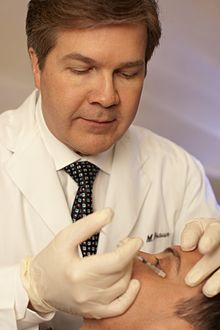User:Scholar0001/sandbox
Techniques for reducing the appearance of aging wrinkles[edit]

Current evidence suggests that tretinoin decreases cohesiveness of follicular epithelial cells, although the exact mode of action is unknown. Additionally, tretinoin stimulates mitotic activity and increased turnover of follicular epithelial cells.[1] Tretinoin is better known by the brand name Retin-A.
Topical glycosaminoglycans supplements can help to provide temporary restoration of enzyme balance to slow or prevent matrix breakdown and consequent onset of wrinkle formation. Glycosaminoglycans (GAGs) are produced by the body to maintain structural integrity in tissues and to maintain fluid balance. Hyaluronic acid is a type of GAG that promotes collagen synthesis, repair, and hydration. GAGs serve as a natural moisturizer and lubricant between epidermal cells to inhibit the production of matrix metalloproteinases (MMPs).
Dermal fillers are injectable products frequently used to correct wrinkles, and other depressions in the skin. They are often a kind of soft tissue designed to enable injection into the skin for purposes of improving the appearance. The most common products are based on hyaluronic acid and calcium hydroxylapatite.
Botulinum toxin is a neurotoxin protein produced by the bacterium Clostridium botulinum. Botox is a specific form of botulinum toxin manufactured by Allergan for both therapeutic and cosmetic use. Besides its cosmetic application, Botox is used in the treatment of other conditions including migraine headache and cervical dystonia (spasmodic torticollis) (a neuromuscular disorder involving the head and neck).[2]
Dysport, manufactured by Ipsen, received FDA approval and is now used to treat cervical dystonia as well as glabellar lines in adults. In 2010, another form of botulinum toxin, one free of complexing proteins, became available to Americans. Xeomin received FDA approval for medical indications in 2010 and cosmetic indications in 2011.
Botulinum toxin treats wrinkles by immobilizing the muscles which cause wrinkles. It is not appropriate for the treatment of all wrinkles; it is indicated for the treatment of glabellar lines (between the eyebrows) in adults. Any other usage is not approved by the FDA and is considered off-label use.
Laser resurfacing is FDA-cleared skin resurfacing procedure in which lasers are used to improve the condition of the skin.[citation needed] Two types of lasers are used to reduce the appearance of fine lines and wrinkles on the face; laser ablation, which removes thin layers of skin, and nonablative lasers that stimulate collagen production. Nonablative lasers are less effective than ablative ones but they are less invasive and recovery time is short. After the procedure people experience temporary redness, itching and swelling.
Preventing wrinkles without medical treatments[edit]
Technically, wrinkles cannot be completely prevented but there are many ways you can stop them early on by keeping up with a healthy lifestyle. To do so, make sure you are nourishing your body with clean foods and water while avoiding toxins like smoking. Be mindful on protecting yourself from UV rays and taking care of your skin with gentle products.[3]
- ^ Stefanaki C, Stratigos A, Katsambas A (June 2005). "Topical retinoids in the treatment of photoaging". J Cosmet Dermatol. 4 (2): 130–4. doi:10.1111/j.1473-2165.2005.40215.x. PMID 17166212. S2CID 44702740.
- ^ Brin MF, Lew MF, Adler CH, Comella CL, Factor SA, Jankovic J, O'Brien C, Murray JJ, Wallace JD, Willmer-Hulme A, Koller M (1999). "Safety and efficacy of NeuroBloc (botulinum toxin type B) in type A-resistant cervical dystonia". Neurology. 53 (7): 1431–8. doi:10.1212/WNL.53.7.1431. PMID 10534247.
- ^ "Skin Care and Aging". National Institute on Aging. Retrieved 2022-08-17.

